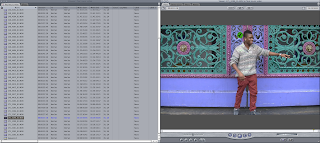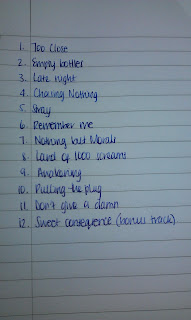How did you use media technologies in the construction and research, planing and evaluation stages...?
There is a range of technology I have used through out this project that has allowed me to create effective media texts. There was one form of technology that was crucial in every stage for us- the internet. I used the internet for most of my research, whether it was YouTube to watch music videos for inspiration or sharing sites such as Photobucket and SlideShare to present my work. The internet also helped me to research into the different theories (Goodwin, Vernallis & Mulvey) and examples of it in music videos.At the beginning, I also used Facebook to ask Alex Clare for permission to use his song, although he never replied :(I also used Facebook to do some of the audience research by asking Alex Clare fans on his official Facebook page what sort of things they would expect from our video.
After getting our rough idea of what our video would eventually look like, we created an animatic storyboard to present the ideas.

The next step was, of course, editing. Now was the time to see if our footage was any good...
There were two main technological products we used, the Mac (hardware) and FinalCut Pro (editing software.) Editing is a huge part of a successful video and we edited everything on FCP. We marked the beats of the song according to where we wanted the cuts to be in the video. Everything had to be very precise to make sure the lyp sync was perfect.
 We further used effects such as brightener and slow motion to enhance our video. Slow motion had a huge impact in the effectiveness of our final video because we used it to build up tension and anticipation at the beginning, which worked well in harmony with the slow beats. The photos below are of the main editing process.
We further used effects such as brightener and slow motion to enhance our video. Slow motion had a huge impact in the effectiveness of our final video because we used it to build up tension and anticipation at the beginning, which worked well in harmony with the slow beats. The photos below are of the main editing process.During the digipak and poster, I used Photoshop. Although I had never used the software before, YouTube tutorials taught me what I need to know. I didn't use too many effects in my digipak and poster because it distorts the product. Because the photos were taken at night, I adjusted brightness and contrast to make the photos clearer. I also used the lasso tool to cut around the pictures of Marcus Green to be put on the dark background.
I used Blogger to blog about every step of our journey throughout this project. It was effective in showing progress and obstacles as well as research and ideas. I also found it an effective way to communicate with the group, such as posting changes to filming schedules. I particularly liked using SlideShare and Photobucket as they are visually creative ways to present my work.
Before creating the digipak, we had come up with the names of all the songs we would use in for the album. We had to think very carefully and creatively because we wanted the songs to reflect Marcus' journey and change. We used a name generator, which helped us with a few of the names by giving us synonyms rather than just plain words.
Finally, here is a Camtasia clip of me just browsing through this blog.









No comments:
Post a Comment